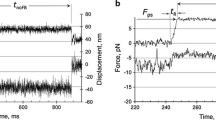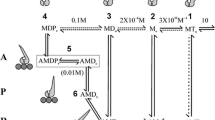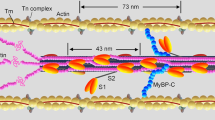Summary
Recent experiments on the kinetics of the interaction between myosin subfragment 1 (S1) and F-actin in solution are summarized. It is concluded that, at every step of the ATPase cycle, the association between the two proteins takes place in two stages. The equilibrium constant of the second step and thus the affinity of S1 for actin changes from step to step during the enzymatic reaction.
It is proposed that the transient kinetic evidence can be interpreted in terms of two different classes of contraction models. The first one, which is widely used at present, identifies particular steps in the enzymatic reaction as directly responsible for the conformational change which represents the power stroke of muscle contraction (direct coupling model). In the second class of model, to which we wish to draw attention, changes in affinity modulated by the enzymatic reaction result in changes in the relative amounts of time spent by parts of the myosin molecule in two different environments. These environments determine whether the molecule exists in the ‘long’ or ‘short’ state, and it is the transition between these two which constitutes the power stroke (indirect coupling model).
Similar content being viewed by others
References
BAGSHAW, C. R., ECCLESTON, J. F., ECKSTEIN, F., GOODY, R. S., GUTFREUND, H. & TRENTHAM, D. R. (1974) The Mg2+-adenosine triphosphatase of myosin: Two step processes of ATP association and ADP dissociation.Biochem. J. 141, 351–64.
BIOSCA, J. A., BARMAN, T. E. & TRAVERS, F. (1984) Transient kinetics of the binding of ATP to acto-subfragment-1. Evidence that the dissociation of acto-subfragment-1 by ATP leads to a new conformation of subfragment-1.Biochemistry 23, 1947–54.
CHALOVICH, J. M. & EISENBERG, E. (1982) Inhibition of actomyosin ATPase activity by troponin-tropomyosin without blocking the binding of myosin to actin.J. biol. Chem. 257, 2432–7.
DIEBLER, H., EIGEN, M., ILGENFRITZ, G., MAAS, G. & WINKLER, R. (1969) Kinetics and mechanism of reactions of main group metal ions with biological carriers.Pure Appl. Chem. 20, 93–115.
EISENBERG, E. & GREENE, L. (1980) The relation of muscle biochemistry to muscle physiology.Ann. Rev. Physiol. 42, 293–309.
GEEVES, M. A. & GUTFREUND, H. (1982) The use of pressure perturbations to investigate the interaction of rabbit muscle myosin subfragment-1 with actin in the presence of MgADP.FEBS Lett. 140, 11–5.
GOLDMAN, Y. E., HIBBERD, M. G., MCCRAY, J. A. & TRENTHAM, D. R. (1982) Relaxation of muscle fibres by photolysis of caged-ATP.Nature 300, 701–5.
GOODY, R. S., HOFMANN, W. & MANNHERZ, H. G. (1977) The binding constant of ATP to myosin subfragments.Eur. J. Biochem. 75, 317–24.
GOODY, R. S. & HOLMES, K. C. (1983) Cross-bridges and the mechanism of muscle contraction.Biochim. Biophys. Acta 726, 13–39.
GUTFREUND, H. (1975) Kinetic analysis of the properties and reactions of enzymes.Prog. Biophys. molec. Biol. 29, 161–95.
HARRINGTON, W. F. (1971) A mechanochemical mechanism for muscle contraction.Proc. natn. Acad. Sci. USA 68, 685–9.
HARRINGTON, W. F., UENO, H. & TSONG, T. Y. (1983) Cross-bridge movement in muscle and the conformation of the myosin hinge. InMobility and Function of Proteins and Nucleic Acids (edited by PORTER, R., O'CONNOR, M. and WHELAN, J.), Ciba Foundation Symposium 93, pp. 186–207. London: Pitman.
HUXLEY, A. F. (1973) A note suggesting that the cross-bridge attachment during muscle contraction may take place in two stages.Proc. R. Soc. 183, 83–6.
KONRAD, M. & GOODY, R. S. (1982) Kinetic and thermodynamic properties of the ternary complex between F-actin, myosin subfragment-1 and adenosine 5′-β, γ-imido triphosphate.Eur. J. Biochem. 128, 547–55.
MILLAR, N. & GEEVES, M. A. (1983) The rate-limiting step of the ATP-mediated dissociation of actin from rabbit skeletal muscle myosin subfragment-1.FEBS Lett. 160, 141–8.
PERUTZ, M. F. (1980) Stereochemical mechanism of oxygen transport by haemoglobin.Proc. R. Soc. Lond. 208, 135–62.
SHOHAM, M. & STEITZ, T. A. (1982) The 6-hydroxymethyl group of a hexose is essential for the substrate induced closure of the cleft in hexokinase.Biochim. Biophys. Acta 705, 380–4.
SHRIVER, J. W. & SYKES, B. D. (1981a) Phosphorus-31 nuclear magnetic resonance evidence for two conformations of myosin subfragment-1. nucleotide complexes.Biochemistry 20, 2004–12.
SHRIVER, J. W. & SYKES, B. D. (1981b) Energetics and kinetics of interconversion of two myosin subfragment-1. adenosine 5′ diphosphate complexes as viewed by phosphorus-31 nuclear magnetic resonance.Biochemistry 20, 6357–62.
SHRIVER, J. W. & SYKES, B. D. (1982) Energetics of the equilibrium between two nucleotide-free myosin subfragment 1 states using fluorine-19 nuclear magnetic resonance.Biochemistry 21, 3022–28.
SLEEP, J. A. & HUTTON, R. L. (1980) Exchange between inorganic phosphate and adenosine 5′-triphosphate in the medium by actomyosin subfragment 1.Biochemistry 19, 1276–83.
TAYLOR, E. W. (1979) Mechanism of actomyosin ATPase and the problem of muscle contraction.Crit. Rev. Biochem. 6, 103–64.
TRENTHAM, D. R., ECCLESTON, J. F. & BAGSHAW, C. R. (1976) Kinetic analysis of ATPase mechanisms.Q. Rev. Biophys. 9, 217–15.
WHITE, H. D. (1977) Magnesium-ADP binding to acto-myosin S1 and acto-heavymeromyosin.Biophys. J. 17, 40a.
WRAY, J. (1984) Cross-bridge states in invertebrate muscles. InCross-bridge Mechanisms in Muscle Contraction (edited by POLLACK, G. H. and SUGI, H.). New York: Plenum Press (in press).
Author information
Authors and Affiliations
Rights and permissions
About this article
Cite this article
Geeves, M.A., Goody, R.S. & Gutfreund, H. Kinetics of acto-S1 interaction as a guide to a model for the crossbridge cycle. J Muscle Res Cell Motil 5, 351–361 (1984). https://doi.org/10.1007/BF00818255
Received:
Issue Date:
DOI: https://doi.org/10.1007/BF00818255




